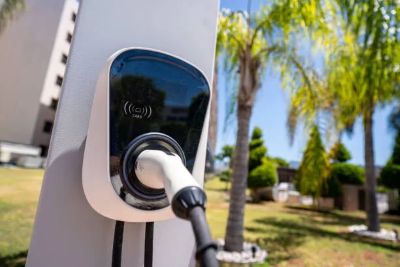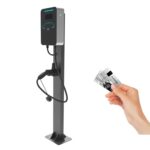EV Charging Safety: A Comprehensive Guide
As electric vehicles (EVs) become more common, ensuring safety at EV charging stations is crucial—whether at home, in public spaces, or at businesses. This guide will help you understand the key safety practices for different charging levels, how to maintain your equipment, and general best practices to ensure your charging experience is safe, efficient, and hassle-free.
Understanding the Different EV Charging Levels
There are three primary types of China EV chargers: Level 1, Level 2, and DC Fast Charging (Level 3). Each has distinct power requirements and associated safety considerations.
Level 1 Charging: Slow but Simple
Level 1 uses a standard 120V outlet, the same type as household appliances. This is the easiest form of charging, ideal for plug-in hybrid electric vehicles (PHEVs) or EVs with limited daily driving distances.
-
Charging Speed: Adds 3-5 miles of range per hour.
-
Installation: No special equipment needed; plug into a standard outlet.
-
Best For: PHEVs or low-mileage EVs.
Safety Tips for Level 1 Charging:
-
Use a dedicated outlet that can handle the charger’s amperage. Avoid sharing outlets with other devices.
-
Never use extension cords or power strips—these can overheat and cause fires.
-
Ensure the charger is UL or CSA certified.
-
Keep cables secured to avoid tripping hazards and inspect regularly for wear or damage.
Level 2 Charging: Faster and More Efficient
Level 2 uses a 240V outlet, similar to those for dryers or ovens, and requires professional installation. It’s ideal for EV owners with longer commutes.
-
Charging Speed: Adds 20-60 miles of range per hour.
-
Installation: Requires a dedicated 240V circuit and professional setup.
-
Best For: Overnight charging and daily use at home or workplaces.
Safety Tips for Level 2 Charging:
-
Hire a licensed electrician for installation to prevent electrical risks.
-
Install a dedicated circuit to avoid overloading your home’s electrical system.
-
Use a charger with built-in ground fault circuit interrupter (GFCI) protection or install an additional GFCI breaker.
-
Ensure the charging station is weatherproof if used outdoors.
-
Regularly inspect the equipment, replacing any worn parts immediately.
DC Fast Charging (Level 3): High Power for Public Use
DC Fast Charging is designed for commercial use, delivering rapid charging with direct current (DC). It can charge an EV to 80% in 20-40 minutes.
-
Charging Speed: Adds 60-100+ miles of range in 15-30 minutes.
-
Installation: Requires specialized, industrial-grade infrastructure.
-
Best For: Long-distance travel or quick top-ups.
Safety Tips for DC Fast Charging:
-
Only use trusted public networks with well-maintained stations.
-
Never force a plug if it doesn’t fit easily—doing so can cause damage.
-
Monitor your vehicle’s charging status and avoid leaving it plugged in after it’s fully charged.
-
If you notice sparks, smoke, or unusual smells, stop charging immediately and notify the provider.
General Safety Tips for All Charging Levels
Regardless of the charging level you’re using, certain safety principles apply across the board.
-
Use Certified Equipment:
Only purchase chargers certified by nationally recognized bodies (e.g., UL, CSA, ETL). Certification ensures the product has passed rigorous safety testing. -
Avoid Water Exposure:
Never charge in wet or rainy conditions unless your charger is rated for outdoor use. Always use a weatherproof cover and dry off connectors if they appear damp. -
Install a Residual Current Device (RCD):
An RCD detects electrical imbalances and shuts off power to prevent shocks or fires. Many Level 2 chargers come with built-in RCD protection. -
Keep Charging Components Out of Reach of Children:
EV chargers, cables, and connectors should be stored securely out of reach of children to avoid electric shock or tripping hazards. -
Perform Routine Inspections:
Inspect charging equipment regularly for signs of damage, such as cracked insulation, exposed wires, or scorch marks. Replace any worn or damaged parts immediately.
Home EV Charging: Planning and Preparation
Installing an EV charger at home offers convenience but requires careful planning to ensure safety and compliance.
-
Hire a Qualified Electrician:
Do not attempt to install a 240V charger yourself unless certified. A professional will:-
Evaluate your home’s electrical capacity.
-
Install a dedicated circuit for safe charging.
-
Ensure compliance with local codes and permit requirements.
-
-
Choose the Right Location:
Install the charger in a well-ventilated space, protected from rain and direct sunlight, and easily accessible for your vehicle’s charging port. -
Obtain Necessary Permits:
Check with your local municipality for permit requirements. Some areas require permits and inspections for EV charger installations.
Public Charging Station Etiquette and Awareness
When using public EV charging infrastructure, safety goes hand-in-hand with courtesy. Here’s how to stay safe and respectful at public stations:
-
Park Considerately:
Don’t leave your vehicle plugged in longer than necessary, especially after it’s fully charged. -
Inspect Equipment Before Use:
Always check for signs of damage. If you encounter a malfunctioning station, report it to the operator and avoid using it. -
Avoid Blocking Cables:
Position your vehicle so the cable doesn’t stretch, bend, or lie under your tires. -
Stay Aware of Your Surroundings:
Public charging stations can be in poorly lit or unfamiliar areas. Be vigilant, especially at night.
Responding to Charging Emergencies
While charging accidents are rare, it’s important to be prepared for emergencies:
-
Overheating or Fire: Unplug the charger if it’s safe. If not, move away and call emergency services.
-
Shocks or Sparks: Immediately stop charging and notify an electrician or station operator.
-
Tripped Breakers or Blown Fuses: These may indicate an electrical issue. Consult a professional before resuming use.
Conclusion: Charge Smart, Charge Safe
As EVs continue to shape the future of transportation, adopting safe charging practices is essential. Whether charging at home or at a public station, following these safety tips will help you ensure a secure and efficient charging experience.
By investing in certified equipment, following installation best practices, and staying aware of maintenance and safety concerns, you can enjoy the benefits of electric driving with confidence and peace of mind.Know more about Google SEO Directory


